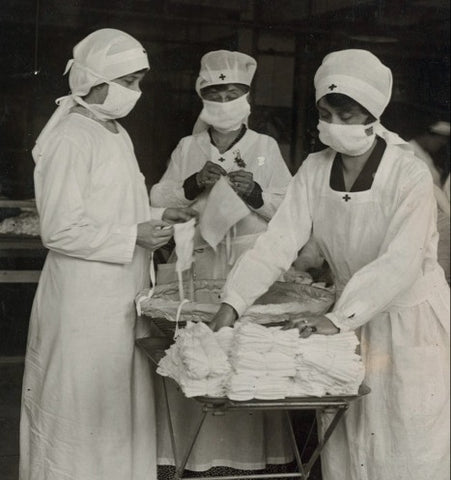History of the surgical mask and generalization of disposable masks

Mask worn to fight against the plague in the 17th century
The shortage of protective masks during the COVID-19 pandemic has become a symbol of the fragility of modern medicine and public health. Several explanations have been put forward to explain this situation, ranging from public panic hoarding the masks to the outsourcing of manufacturing and the disruption of world trade. The history of medicine suggests that another factor could be taken into account: the gradual replacement of reusable masks by disposable masks since the 1960s. Medicine has been transformed by the culture of consumption - what Life magazine has enthusiastically dubbed "Throwaway Living" in 1955. The history of the surgical mask sheds light on how this vulnerability was created.
The protective port goes up at the beginning of modern Europe
Covering the nose and mouth was part of the traditional sanitary practices against contagious diseases in early modern Europe. This protection consisted mainly of neutralizing the miasma in the air thanks to the perfumes and spices contained under a mask, like the masks of the plague doctors, which resemble birds. However, these practices had become marginal in the 18th century. Protective masks, as used today in healthcare and in the community, largely date back to a more recent period when a new understanding of contagion based on the theory of germs was applied to surgical medicine.
From the first scientific studies in the 19th century
In 1867, British surgeon Joseph Lister postulated that wound disease was caused by the germs of the microscopic living entities that Louis Pasteur had recently described. Lister suggested eliminating germs through the use of antiseptic substances. But in the 1880s, a new generation of surgeons came up with the strategy of asepsis which aimed to prevent germs from entering wounds in the first place. It was a risky strategy. The operator's hands, instruments and even exhalations were now suspect. Johann Mikulicz, head of the department of surgery at the University of Breslau (now Wroclaw, Poland) began working with local bacteriologist Carl Flügge, who had experimentally demonstrated that respiratory droplets carried cultivable bacteria. In response to these findings, Mikulicz began wearing a protective mask in 1897. This mask represented an infection control strategy that aimed to ward off all germs, rather than kill them with chemicals.
The use of the principle mask during the Spanish influenza pandemic
 It was primarily the use of the mask to cover the mouth and nose (and beard) during the Manchurian plague of 1910-11 and the influenza pandemic of 1918-19 that made the face mask a means of protection. medical personnel and infectious disease patients outside of the operating room.
It was primarily the use of the mask to cover the mouth and nose (and beard) during the Manchurian plague of 1910-11 and the influenza pandemic of 1918-19 that made the face mask a means of protection. medical personnel and infectious disease patients outside of the operating room.
At that time, the motivation for wearing masks had already gone beyond their use in the operating room in hospitals: their vocation is now also to protect the wearer against infections.
First half of the 20th century: the advent of the medical mask
In the meantime, masks continued to be developed in medicine. Although doctors agreed on the general function of the mask, in the first decades of the 20th century they attempted to determine the most effective type of mask, and patents were filed on various models. Masks were usually made of several layers of cotton gauze, sometimes with an additional layer of waterproof material, held by a metal frame. Their main purpose was to prevent the transmission of respiratory droplets to and from the wearer, as Mikulicz and Flügge had suggested for the operating room. The majority of the masks were washable and their metal parts could be sterilized, which "allowed the mask to be used for a significant period of time", as explained by an American researcher and inventor, who had patented a medical mask in 1919.
Several medical researchers have tested and compared the filtering effectiveness of reusable masks with experiments involving infectious volunteers wearing masks in an experimental chamber, as well as with observational studies in a clinical setting. They found that the extent to which the masks filtered out bacteria varied widely. But when used correctly, some masks were considered to offer protection against infection.
Transition from a reusable mask to disposable masks
Reusable masks were once an essential part of the medical arsenal. However, industrial production and further research and development of reusable masks were largely halted with the switch to disposable masks in the 1960s. Disposable masks and respirators will certainly remain an essential part of personal protective medical equipment in the world. 'future, since some of them have specific filtration qualities designed for health care situations.
To avoid a new shortage of masks during a future pandemic, it would be necessary to go beyond the constitution of a reserve of disposable masks but to consider more seriously the drawbacks of this culture of single-use objects very harmful to the environment.
Perhaps one day it will again be possible to say about face masks what medical researchers wrote in 1918: "A mask can be washed repeatedly and used indefinitely."
References :
Strasser, B. J., & Schlich, T. (2020). A history of the medical mask and the rise of throwaway culture. The Lancet, 396 (10243), 19-20.
Picture :
Red Cross Workers Fold Reusable Masks During Spanish Flu Pandemic, Boston, MA, USA, March 1919 (Copyright © 2020 Courtesy National Archives)
Are you looking for a mask to effectively protect yourself from new variants of the coronavirus? You are on the right site ! We offer FFP masks for sale, the only type of mask to protect not only the environment but also its wearer thanks to their filtration of inhaled and exhaled air above 94%. Delivery is fast and free from our premises in France.



